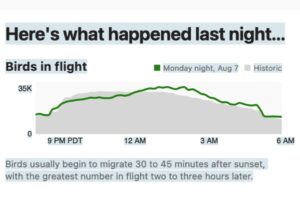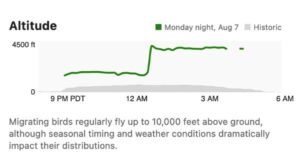Bird conservation depends on connecting people with nature. It’s a win-win in that being in…

Who? Why? When? Where? How? So many questions are asked about bird migration and so many scientific studies are done to supply a rich font of answers.
Why and when? Birds in the Northern Hemisphere migrate in the spring to chase resources— food and nesting sites. They return south in the fall to find readily available food and avoid harsh weather.
Who travels the furthest? Arctic Terns fly the longest distance, migrating 90,000 km (55,923 mi) from pole to pole each year.
What triggers migration? Genetics play a role as do environmental cues, such as changes in food availability, the angle of the sun, and the length of the day.
How do they get ready for the journey? Changes in hormones promote readiness to migrate. The birds experience restlessness and hyperactivity (known as Zugunruhe). Heavy eating helps birds store fat and make muscle. Heart and flight muscles increase in size, but other organs including the stomach, liver, intestines, and reproductive organs often get smaller (presumably so the birds have less unnecessary weight to carry).
How do they know where to go? That depends on the species. Many birds learn the route from experienced individuals during their first migration. Others seem to know innately what direction to head in without having been shown the way.
How do they navigate to find their way? Some birds learn landmarks to help guide them along their migration route, but most employ various senses to determine their direction. Evidence suggests that birds use their internal biological clock, along with environmental cues, as a kind of compass. For example, if you want to go west, fly away from the sun in the morning and toward the sun in the evening. Overcast day? No problem. Birds can see polarized light to know the position of the sun, even when it is obscured by clouds. The majority of birds, even songbirds who are normally active during the day, will migrate at night, using the stars in the night sky to guide them. Birds can also sense the Earth’s magnetic field to help them migrate in the right direction.
It’s exciting to learn about a sense that we humans cannot use. A new study identified the region of the brain that migratory birds use to perceive the magnetic field, and observed that it turns on and off: active when flying, dormant when resting. The authors liken it to being able to attentively listen to music, but also to tune it out when it is playing in the background. Homing pigeons add another sense, that of smell.
How do you keep birds from “cheating” to find their way back home? In one older but memorable experiment, they transported homing pigeons to a distant location. To prevent the birds from getting clues about which way they had been moved, they placed them inside a cylinder filled with bottled air and surrounded by magnetic coils, flashed lights on and off randomly, and played white noise in the background. And just to be sure they weren’t tracking turns from the vehicle, they had them riding on a tilting turntable. While occasionally making them nauseous, it did not interfere with their ability to navigate home.
 With fall migration starting in September, let’s consider what we can do to help. We can reduce hazards to the birds along their route. Fall migration is generally larger because both adults and juveniles are in the skies. That means an increased rate of collisions with man-made structures, especially since juveniles are less experienced. As mentioned above, many birds fly at night and may suffer from light pollution, which interferes with their ability to navigate using the stars. Disorientation caused by artificial lighting often draws the birds down into urban landscapes where they are vulnerable to many hazards. Please remember to check the lights at your home, business, and neighborhood, to be sure they are pointed down, shielded above, and only lit when necessary for security. Consider motion sensor detectors which turn lights on only when needed. Birds don’t recognize glass as a solid object, and far too often fly into it, resulting in fatalities. Cover your windows and glass doors. Close the curtains, shades, or blinds. Attach screens or strings, or apply window films with a dot pattern to the outside of your windows. For more info: abcbirds.org/glass-collisions/
With fall migration starting in September, let’s consider what we can do to help. We can reduce hazards to the birds along their route. Fall migration is generally larger because both adults and juveniles are in the skies. That means an increased rate of collisions with man-made structures, especially since juveniles are less experienced. As mentioned above, many birds fly at night and may suffer from light pollution, which interferes with their ability to navigate using the stars. Disorientation caused by artificial lighting often draws the birds down into urban landscapes where they are vulnerable to many hazards. Please remember to check the lights at your home, business, and neighborhood, to be sure they are pointed down, shielded above, and only lit when necessary for security. Consider motion sensor detectors which turn lights on only when needed. Birds don’t recognize glass as a solid object, and far too often fly into it, resulting in fatalities. Cover your windows and glass doors. Close the curtains, shades, or blinds. Attach screens or strings, or apply window films with a dot pattern to the outside of your windows. For more info: abcbirds.org/glass-collisions/
 Most birds need safe, resource-filled stopover sites along their migratory route. We can help by supporting initiatives that provide this habitat; for instance, protecting forests, wilderness areas, and parks. At home, keep your gardens messy. Birds use leaf litter, dead snags, and branches. They eat seeds from old flower stalks and seek cover in old plants. Take advantage of the season to plant native flowers and shrubs. Nature will keep them watered throughout our rainy season. Then the flowers, seeds, and fruits will be available to birds next spring and summer. Avoid the use of pesticides including herbicides, rodenticides, or insecticides, all of which directly or indirectly impact birds.
Most birds need safe, resource-filled stopover sites along their migratory route. We can help by supporting initiatives that provide this habitat; for instance, protecting forests, wilderness areas, and parks. At home, keep your gardens messy. Birds use leaf litter, dead snags, and branches. They eat seeds from old flower stalks and seek cover in old plants. Take advantage of the season to plant native flowers and shrubs. Nature will keep them watered throughout our rainy season. Then the flowers, seeds, and fruits will be available to birds next spring and summer. Avoid the use of pesticides including herbicides, rodenticides, or insecticides, all of which directly or indirectly impact birds.
Migration is an amazing spectacle; let’s do our part to help birds on their way. And enjoy the coming change of season!



